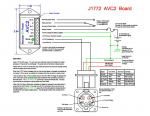This topic has been discussed at length in a theoretical sense, but has glossed over some details.
Out here in Colorado, there are number of EV chargers near good trail riding, and even more near good supermoto riding. I think it would be great to drive the truck and bike out to a riding spot, park next to an EV charger, and just circle back when I need to recharge. The rapid charger and other wiring can stay in the truck, and I can charge with peace and quite. See bad whiteboard drawing below for detail.

However, in looking into making a J1772r to L14-30r converter, I've run into the old 4-prong vs 3 prong issues. A few other post have addressed how to tackle this issue for a 120v adapter, but I'm a little lost about how to deal with it when using both hot lines. The J1772 standard has 2 hots and a ground, while the rapid charger is looking for both hots, neutral and ground. I know just enough about electricity to be dangerous, so I'm a little concerned about the safety of going in this direction. Here are my thoughts/options
Option 1
Connect the hots and the grounds and leave the neutral unused. It's my understanding that this will trip the GFCI, but I don't know. Anyone got any ideas?
Option 2
Connect the hots and hook the bike neutral to the charger ground. Leave the bike neutral unused. I think this means there is no ground fault current path, meaning that if something goes wrong, the current could discharge through me without tripping the breaker. This seems very bad, right?

Option 3
Bridge the neutral and the ground. This seems like the best option to ensure a safe ground fault current path and balanced current for the GFCI. However, I have been told that in the context of home wiring that adding a second neutral-ground bridge outside of the junction box is bad. I don't fully understand why this is bad, but I don't want to forge ahead without understanding the ramifications for this application.

So yeah: is this do-able? I know I've seen other adapters online, but just because someone is selling one online does not mean it is done right.
Out here in Colorado, there are number of EV chargers near good trail riding, and even more near good supermoto riding. I think it would be great to drive the truck and bike out to a riding spot, park next to an EV charger, and just circle back when I need to recharge. The rapid charger and other wiring can stay in the truck, and I can charge with peace and quite. See bad whiteboard drawing below for detail.
However, in looking into making a J1772r to L14-30r converter, I've run into the old 4-prong vs 3 prong issues. A few other post have addressed how to tackle this issue for a 120v adapter, but I'm a little lost about how to deal with it when using both hot lines. The J1772 standard has 2 hots and a ground, while the rapid charger is looking for both hots, neutral and ground. I know just enough about electricity to be dangerous, so I'm a little concerned about the safety of going in this direction. Here are my thoughts/options
Option 1
Connect the hots and the grounds and leave the neutral unused. It's my understanding that this will trip the GFCI, but I don't know. Anyone got any ideas?

Option 2
Connect the hots and hook the bike neutral to the charger ground. Leave the bike neutral unused. I think this means there is no ground fault current path, meaning that if something goes wrong, the current could discharge through me without tripping the breaker. This seems very bad, right?

Option 3
Bridge the neutral and the ground. This seems like the best option to ensure a safe ground fault current path and balanced current for the GFCI. However, I have been told that in the context of home wiring that adding a second neutral-ground bridge outside of the junction box is bad. I don't fully understand why this is bad, but I don't want to forge ahead without understanding the ramifications for this application.

So yeah: is this do-able? I know I've seen other adapters online, but just because someone is selling one online does not mean it is done right.




